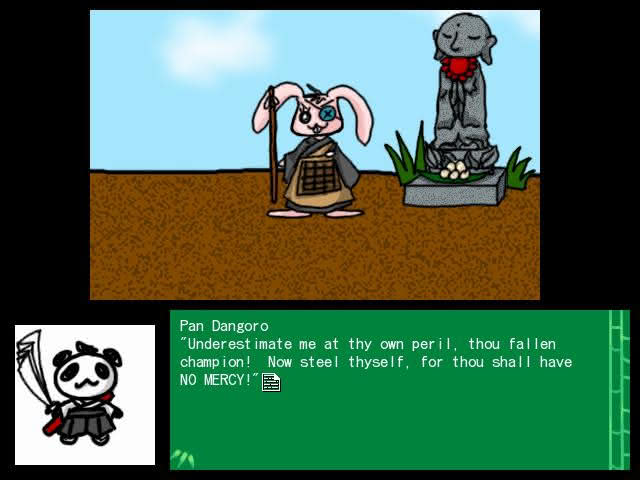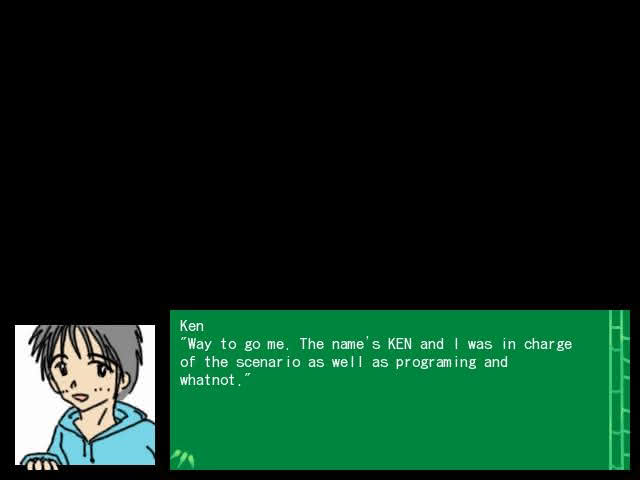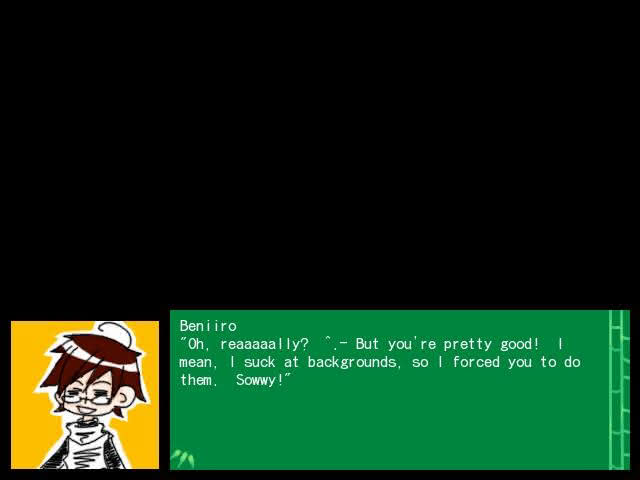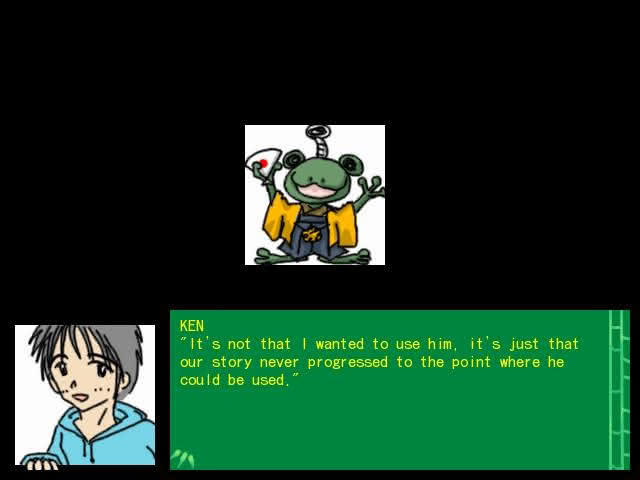Instant Death! Panda Samurai (“Panda Samurai”) is a freeware doujin (think indie) visual novel from Japan that was created by a two-man team consisting of KEN and Beniiro. It was originally released in Japan on January 14, 2003, under the name Hissatsu Panda Samurai. The creators of Panda Samurai gave their consent for the game to be officially translated into English by Mr. Erik Sjoberg, working under the supervision of Mr. Seung Park, for the 2006 al|together translation festival. I am working on reviewing nearly all of the visual novels that were translated for the 2005, 2006, and 2008 al|together festivals (see introduction and my completed reviews). Panda Samurai will be my fifth review of the series.

Panda Samurai takes about 10 minutes to read through. It is the first visual novel I have read that has more bonus content (in the form of credits and post-game author conversations) than in-game content. It defies a clear and concise description, so I will go with the one provided on its official English website page: “Once upon a time, there lived a panda samurai, brave and true. The rest, dear reader, is up to you!”
Spoiler Notice
Panda Samurai is the third very short visual novel that I have reviewed after The Poor Little Bird and From the Bottom of the Heart. The first two games worked to tell meaningful stories in a concise package. Panda Samurai is a comedic effort. It has a story, but it is neither a moral tale nor a story of love and loss. I will not spoil the story of Panda Samurai more than what is necessary to write the instant review. However, I will spoil the game’s lone interactive mechanic in its final scene. The mechanic did take me by surprise, so consider this your fair warning if you would prefer to play through Panda Samurai yourself without any knowledge before reading my review. You will find the download links in the next section.
Panda Samurai Details

- Name: Instant Death! Panda Samurai (EN); Hissatsu Panda Samurai (JP)
- Created By: KEN and Beniiro
- Translated By: Erik Sjoberg under the supervision of Seung Park (Insani)
- Original Release: January 14, 2003 (JP)
- English Release: August 19, 2006 (EN)
- Platform: Windows, Mac, and Linux
- VNDB Entry: Link
- Official Website: al|together 2006; Insani
You can view an archived version of the original Japanese website for Panda Samurai here.
Downloading Panda Samurai
Panda Samurai can be downloaded from its official website on Insani or the al|together 2006 festival. I recommend downloading it from the al|together site because that location has direct download links in addition to torrent downloads. I had no issue with downloading Panda Samurai directly for Windows and Linux, and I tested the Mac download to confirm that it works. I will provide links to the direct downloads below:
Despite running Linux, I could not get the Linux version of Panda Samurai to work (I experienced a similar issue with my previous review, Shooting Star Hill). The Windows version ran with one minor issue under Wine on Linux. I did not test the Mac version because I do not have any devices running Mac OS.
Sound Issue For Me on Linux
For whatever reason, the Panda Samurai launched and ran without sound while running on top of a compatibility layer on Linux. Recall that I had a similar issue with the music in one of my earlier reviews, Night of the Forget-Me-Nots. The game file comes with one sound file (a .midi track) that I was able to run outside of the game, so I do not know what the background music sounds like. I assume that someone who is a bit more technically inclined and willing to put time into it could determine my issue with the sound in certain al|together games under Wine.
General Overview of Panda Samurai
The player in Panda Samurai takes the role of a samurai who happens to be a panda. This panda, Pan Dangoro, has fallen on some hard times. The story’s conflict arises after Pan Dangoro fails to secure a job at the local job board (which is run by a bat, because why would it not be?). Pan Dangoro comes across a food offering. Before he can take the food, he is confronted by a priest (or is it a priest?).
Game-Play of Panda Samurai
Panda Samurai is a pure kinetic visual novel – meaning no choices or player input – for about 80% of its run. Unlike other visual novels that I covered, Panda Samurai does not even have a menu or save functionality (talk about minimalist design). The end of the game, which features Pan Dangoro facing off against a difficult opponent, turns into a multi-choice quiz where the player must choose the correct answers to win the duel.
In order to win the duel, the player must answer five questions correctly. Each question has three choices. It appears that answering two questions incorrectly causes the player to lose the duel and end with a game over. I played through Panda Samurai five times (intentionally losing twice) and saw a total of 12 different questions – leading me to conclude that the questions are chosen at random.
Visual Presentation of Panda Samurai
Panda Samurai has a fun visual aesthetic. See some screenshots below.


The screen is split in two. The bottom third consists of a text box (which turns into a choice-selection box during the quiz portion of the game) and a portrait of Pan Dangoro that sometimes changes depending on what Pan Dangoro is saying or thinking. The top two-thirds of the screen features a background along with whichever character Pan Dangoro is interacting with. The quiz segment, which I will not spoil, features some light battle animations.
The visuals are the most memorable aspect of Panda Samurai next to the strange quiz duel at the end of the story. They are simple, but I enjoyed the style and they stand out as one of the more unique looks from the al|together translations.
Audio Presentation of Panda Samurai
This is hard for me to review because I was unable to play Panda Samurai with audio. From what I found in the game files, it appears that Panda Samurai has a single sound-track. The sound-track fit the theme of the game, but it did not stand out to me beyond providing some fitting background music for the short story.
Translation Quality
Unlike some of the visual novels that I have looked at from the al|together project, Panda Samurai did not come with translator notes and comments. This is a shame because, given its content, I assume it called for a decent amount of translator discretion on two points.
Firstly, the dialogue in Panda Samurai is deliberately (and comically) archaic and verbose, especially when the protagonist, Pan Dangoro, is speaking. Even the narrator gets in on the act.

And thus our mighty hero turns a new leaf in his divine passion play of unemployment.
While I do not know what the translators were working with, the end result makes for good reading. Like all of the al|together translations I have reviewed thus far, the English output is terrific and better than most commercially translated visual novels. Panda Samurai’s style would have likely become grating had the game been much longer, but Insani did a good job of playing up the style to good effect while retaining the writing style and the points and jokes .
The quiz portion of the game likely required some interesting translation choices. As I noted above, I saw twelve questions in five play-throughs of Panda Samurai. The questions covered a range of topics including the legend of King Arthur, weapons in Japanese video games, historical figures in Japanese video games, panda history, fencing, samurai, and warfare in the Holy Roman Empire. I do not know how close the English questions were to the questions in the original Japanese version of the game. The only questions I got wrong unintentionally were about panda conservation history in China and about a video game that I had never heard of – so the end result of the translation produced questions that were intelligible to me at least. I would be curious to know how the translators worked through bringing the questions and choices from the original Japanese Panda Samurai to English, but unfortunately there are no notes about their work and thought process.
Writing Quality and Story
The Panda Samurai README file (you will find it if you download the game) includes the following text:
Comic software shot No. 1! Will the Panda Samurai manage to engulf everyone in a whirl of laughter!? Well, even if you’re not engulfed I will be grateful for just a little wry smile (lol).
That sums Panda Samurai’s writing and story up well. This is the first al|together project that I covered that does not take itself seriously at all. It is, from start to finish, a comedy featuring a deadbeat panda samurai, many panda puns, and a lightly-explained sword-fight in the form of a multi-choice quiz at the end. There is enough humor to get a “little wry smile” on the first play-through, and the over-the-top writing style goes well with the concept, but there is little in the way of story to analyze or assess.
Bonus Content
After “beating” Panda Samurai, which involves successfully answering five questions to win the sword fight at the end of the game before getting two questions wrong, the player is treated to end credits.
Beating the game unlocks a postscript. The postscript consists of dialogue from Ken and Beniiro, the two-man team behind Panda Samurai. The pair introduce themselves (with their own character illustrations), thank readers for playing, and explain their respective roles in creating Panda Samurai.

After the very short Postscript, the player unlocks “Extra” content on the home menu. The Extra content is another conversation between Ken and Beniiro. This conversation is quite a bit longer, and the pair goes into more detail about their roles on Panda Samurai and their respective strengths and weaknesses.

They also show portraits for characters that were planned in development but scrapped for the final version of Panda Samurai.

Toward the end of the extra content, Ken wryly acknowledges that the Postscript and Extra content are longer than Panda Samurai itself.
The postscript and extra content are fun additions to Panda Samurai. I doubt that Mr. Ken and Mr. Beniiro expected that someone would be reading their little conversation nearly twenty years after they put it together in late 2002 or early 2003 (much less reading an official English translation of it). From the extra content, I gleaned that Panda Samurai was something of an experimental project in visual novel making done both for fun and to try putting different ideas and concepts into practice. I also came away with the impression that the final version of Panda Samurai was shorter than what may have been planned at an earlier stage of the project. It was interesting to learn how the developers divided responsibilities based on their strengths and weaknesses. The extra content stands as an interesting historical piece into doujin visual novel design in the early 2000s.
My Overall Review and Recommendations
Panda Samurai is a fun experiment in visual novel-design to play once. The visuals, simple as they are, are distinct and memorable. There is little plot to speak of, but the absurd dialogue and strange quiz-sword fight stand out for me from the experience. For those who are interested in game design, the extra content makes for good reading and a way to acknowledge the effort of the two-man team that created the game and the team at Insani that translated it into English.
There is not enough content in Panda Samurai to make me recommend going out of one’s way to read through it in and of itself. However, if you are downloading other games from Insani or the al|together 2006 festival, I recommend adding Panda Samurai to your download list and giving it 10 minutes of your time (add a few minutes if you struggle with quizzes and/or want to consume the extra content). There is a bit to appreciate in its strange humor and unique ending.